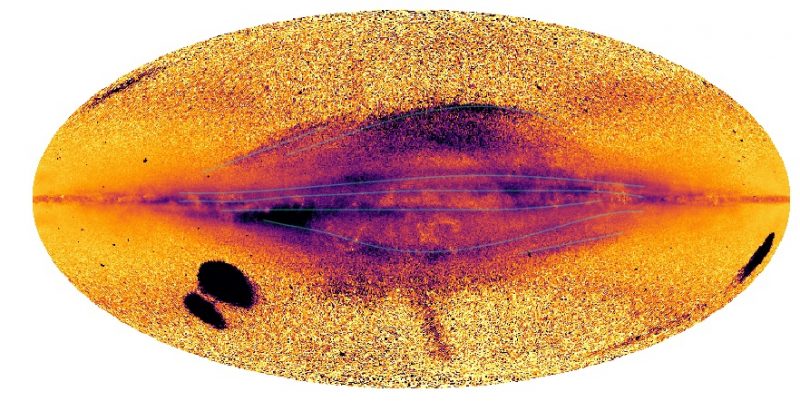
Possible fossil spiral arms
The European Space Agency’s Gaia space observatory orbits the sun out at Lagrange point 2, aka L2, a point some four times the moon’s distance away. ESA has called this point “a preeminent location for advanced spaceprobes.” And indeed Gaia is about to get more company. The James Webb Space Telescope – Hubble’s successor, currently due to launch Christmas Day – will also go to L2. In the meantime, since its launch in 2013, Gaia has been hard at work on its mission to create a first-ever comprehensive 3D map of our Milky Way galaxy. It has already mapped and measured the motions of more than a billion stars. And, in the process, Gaia has made fascinating discoveries about our galaxy. On December 13, 2021, astronomers announced the newest Gaia insight into our galaxy. Using Gaia data, they’ve found evidence for fossil spiral arms of the galaxy, from long ago.
We know that – like many other galaxies in our universe – our Milky Way is a spiral galaxy. The scientists, including lead author Chervin Laporte of the Institute of Cosmos Sciences of the University of Barcelona, created a new preliminary map of the Milky Way’s outer disk. Some of the new structures they’ve uncovered point to evidence for fossil spiral arms.
The peer-reviewed journal Monthly Notices of the Royal Astronomical Society: Letters published their findings on October 18, 2021.
The scientists saw structures they already knew about, along with many previously unknown spinning filamentary structures at the edge of the Milky Way disk. Computer simulations had shown that filamentary structures would form in the outer disk from past interactions with satellite galaxies. But the astronomers weren’t expecting to find so many of these filaments in their map assembed with Gaia data. How these structures came to be remains a mystery.
Mysterious structures in Milky Way disk
The scientists believe, that over the eons, interactions with satellite galaxies formed the filamentary structures – possible remnants of spiral arms from long ago – in the Milky Way’s disk. While the Large and Small Magellanic Clouds are the most famous satellite galaxies, the Milky Way currently has 50 known small satellite galaxies surrounding it. Plus, our galaxy is believed to have enveloped or “eaten” many more satellite galaxies in the past.
The Sagittarius Spheroidal Dwarf Galaxy, seen in the image at top, is currently playing a losing game of tug-of-war with our Milky Way. The Milky Way won an earlier, similar battle with another lightweight, called the Gaia Sausage Galaxy. Its remains lie in the outer edges of our galaxy.
This same team of scientists said in an earlier study that a filamentary structure in the opposite direction from the galaxy’s center contained stars more than 8 billion years old. If that’s the case, those stars would be too old to be a result of interactions with the Sagittarius Spheroidal Dwarf Galaxy. Instead, they’re likely to be leftovers from our Milky Way’s interaction with the Gaia Sausage.

An alternate theory
Scientists also theorized that the thready structures aren’t true fossil spiral arms but could be the crests of large-scale vertical distortions in the Milky Way disk. Laporte said:
We believe that disks respond to satellite impacts that set up vertical waves that propagate like ripples on a pond.
To resolve the competing explanations, the team will use the William Herschel Telescope on the Canary Islands to study the stars in these structures more closely. Laporte said:
Typically this region of the Milky Way has remained poorly explored due to the intervening dust, which severely obscures most of the galactic midplane. While dust affects the luminosity of a star, its motion remains unaffected. We were certainly very excited to see that the Gaia motions data helped us uncover these filamentary structures! Now the challenge remains to figure what these things exactly are, how they came to be, why in such large numbers, and what they can tell us about the Milky Way, its formation and evolution.
Bottom line: A team of scientists using Gaia data has examined filamentary structures in the disk of our Milky Way galaxy. They think these structures might be fossil spiral arms from long ago.











